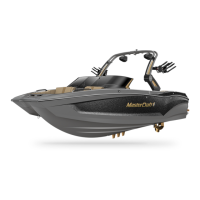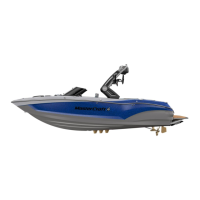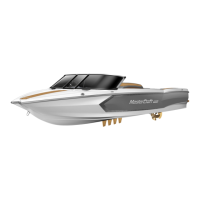2017 OWNERS MANUAL / 378
required at certain times when temperatures increase. In addition
to preventing water intrusion, sealing can prevent the gumming
that occurs when the hydrocarbons in gasoline react with naturally
occurring oxygen. This gummy substance plugs up fuel filters and
injectors. Sealing the tank helps reduce gumming by significantly
limiting the amount of oxygen that is allowed into the fuel tank. If the
tank vent is sealed for storage/winterization, it must be unsealed
prior to the boat being placed back into service. Failure to do so will
result in issues when trying to fill the gas tank in future fill-ups.
Note: Fuel stabilizers work ONLY in fresh gasoline. Stabilizers will
not cure oxygenated gasoline. Adding a stabilizer when the boat
is being prepared for outings after storage will NOT clean the
gumming that has occurred or remove water from the fuel tank or
otherwise eliminate any problems that have occurred due to failure
to properly prepare the fueling system for storage.
Engine manufacturers suggest using Federal or State of California
reformulated gasoline whenever possible as it stores as well or
better than conventional gasoline.
Even quality gasoline that has been properly prepared for storage
should never be stored for a period to exceed one (1) year.
Fuel systems on all boats MUST be properly prepared for storage
periods exceeding two (2) weeks, as outlined in this Owner’s
Manual. Failure to do so may void the warranty.
that water condensation will occur within the fuel system. Water is
particularly harmful to fuel tanks and engines, therefore, follow this
procedure:
Step 1
The fuel tank should be ninety-to-ninety-five percent (90-95%) full
of TOP TIER gasoline. This allows for minimal room in which air can
oxygenate the fuel during diurnal cycles (daily periods of expansion/
contraction of gasoline vapors and air as a result of temperature
changes).
Step 2
Add a biocide additive in the fuel tank to limit microbial growth in the
gasoline. Follow the directions provided by the additive’s manufac-
turer.
Step 3
Add a fuel stabilizer, such as Sta-Bil® (preferably the Marine grade
or Ethanol grade stabilizer) to the fuel tank. Follow the directions
provided by the stabilizer’s manufacturer.
Step 4
Run the engine for at least fifteen (15) minutes while in a body of
water. This allows for the circulation of the additives throughout the
fuel system.
During storage, the tank vents can be sealed. If the vent is sealed,
the tank must NOT be completely filled. A ninety-to-ninety-five per-
cent (90-95%) filled tank allows room for expansion, which will be
GENERAL POWER PACKAGE
PREPARATION
Step 1
Lubricate the throttle and shift linkages and cables with multi-pur-
pose grease.
Step 2
MasterCraft recommends that batteries be removed from the boat
for winter storage. Batteries should be fully charged before being
stored in a cool, dry location, protected from the elements. Fully
recharge the batteries before re-installation in the boat. Never store
batteries close to heat, spark or flame-producing devices.
OTHER WINTERIZATION
PREPARATIONS
Step 1
Remove the bilge drain plug immediately after taking the boat out
of the water. After a general bow-to-stern washing, raise the bow of
the boat higher than the stern to allow as much water as possible to
drain from the bilge.
Step 2
Thoroughly clean the hull, deck and interior of the boat as soon
as it is removed from the water. Cleaning while the boat is still
wet is recommended rather than waiting until the boat is taken
out of storage. Any marine growth in or on the hull will be wet and
easier to remove. Be sure to leave the boat’s storage and engine
compartments opened up so they can properly air dry and prevent
mildew from trapped moisture. (See the Cleaning section of this
Owners Manual.)
Step 3
Apply a coat of wax to the entire surface of the boat. MasterCraft
Premium Marine Wax provides excellent coverage and is
recommended.

